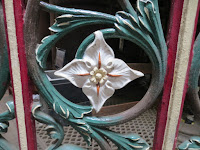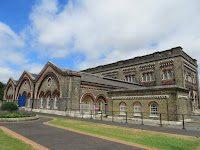Sunday 25 June 2017

Crossness is rather difficult to reach except by car, so I was lucky enough to be offered a trip there as a birthday treat.Navigating was made a little more complex by the fact that Belvedere Road had been renamed (we were pleased to see) Bazalgette Road since the A-Z we were using was printed.

We walked along the footpath from the car park, noticing gradations in the atmosphere from whiff to pong, but not quite to stench, before reaching the handsome buildings of this 1865 temple to modern hygiene.

 The way in is through a mock-up of a sewer, complete with several rats, and we saw that there was an exhibition called 'The Great Stink', a History of London's sewage and its treatment. But we decided to begin with the real things and look at the exhibition later and so, equipped with hard hats, we entered the sumptuously decorated octagonal home of the four great beam engines.
The way in is through a mock-up of a sewer, complete with several rats, and we saw that there was an exhibition called 'The Great Stink', a History of London's sewage and its treatment. But we decided to begin with the real things and look at the exhibition later and so, equipped with hard hats, we entered the sumptuously decorated octagonal home of the four great beam engines.


For those of you who don't know about London's sewage, here's a brief summary: from the earliest years, houses had cess pits, which were emptied by night soil workers, who carted the contents off for use as fertiliser in the fields around London. The rivers of London, though hardly delicious, had rainwater in them, with a few dead cats and so on. As the city grew, and as rich people invested in the amazing, modern water closets, cesspits began to leak, or overflow. and the Thames became appallingly polluted.
During the 1860s, the young engineer Bazalgette offered a solution, and the Metropolitan Board of Works, whose logo embellishes every wall, built these pumping works. Sewage - and waste water - flowed through newly constructed sewers across London, to be pumped into reservoirs and held until the tide began to go out, when it was released into the Thames to flow out to sea. And before you wrinkle your noses and say 'how disgusting' you need to know that this went on till 1886, and was replaced by 'disposal at sea' from sludge ships until 1998, less than 20 years ago.

 Anyway, back to the beam engines. Of the four royally named engines, Prince Consort is the one that is operational (though only to demonstrate, rather than actually pumping any sewage) Albert Edward, Alexandra and Victoria are being restored by the committed volunteers, some of whom were available, in period clothes or in hi-vis jackets, to explain what was going on.
Anyway, back to the beam engines. Of the four royally named engines, Prince Consort is the one that is operational (though only to demonstrate, rather than actually pumping any sewage) Albert Edward, Alexandra and Victoria are being restored by the committed volunteers, some of whom were available, in period clothes or in hi-vis jackets, to explain what was going on.
 It's possible to climb down to see the bottom of each thrust of the pumps, and to see the water storage for generating steam; then one can climb up to admire the great beams from above. James Watt and Company were the suppliers of the machinery. The pumps were subsequently operated by gas, and then electricity, before smaller, diesel engines made them redundant
It's possible to climb down to see the bottom of each thrust of the pumps, and to see the water storage for generating steam; then one can climb up to admire the great beams from above. James Watt and Company were the suppliers of the machinery. The pumps were subsequently operated by gas, and then electricity, before smaller, diesel engines made them redundant One of the people in period dress was female, and we were told that she was the school teacher at the school provided for the children of the workers. Crossness was a long way from the nearest town, and so cottages were built here to house the pump labour force; the school also provided for the children of Woolwich Arsenal.
One of the people in period dress was female, and we were told that she was the school teacher at the school provided for the children of the workers. Crossness was a long way from the nearest town, and so cottages were built here to house the pump labour force; the school also provided for the children of Woolwich Arsenal. When we had seen enough of the great machines, we headed out into the exhibition, which told the whole story of London and its sewage.
When we had seen enough of the great machines, we headed out into the exhibition, which told the whole story of London and its sewage.  The title, The Great Stink, comes from the period when the Thames was so polluted that MPs could not bear to go out onto the terrace, and declared that 'something must be done'.
The title, The Great Stink, comes from the period when the Thames was so polluted that MPs could not bear to go out onto the terrace, and declared that 'something must be done'.  There were portraits of Mr Bazalgette, as well as Thomas Crapper (the firm still in business today), Joseph Bramah, and other lavatorial pioneers. Each section was independent, so if there was a crowd round one exhibit, it was easy to move on and come back later without losing any threads.
There were portraits of Mr Bazalgette, as well as Thomas Crapper (the firm still in business today), Joseph Bramah, and other lavatorial pioneers. Each section was independent, so if there was a crowd round one exhibit, it was easy to move on and come back later without losing any threads.We were interested in the section about Dr John Snow, the man who demonstrated that contaminated water, rather than miasma, was causing cholera (somewhat apt, considering the news from Yemen).


We also very much enjoyed the area with handsome 'thrones' and cistern chains, as well as the repellant description of the various ways inn which people coped until lavatory paper was invented. This research had been done by a student on work experience, and we thought it would enhance any CV or UCAS personal statement: mussel shells? sand?? a lace hanky??? presumably the last only for people with more money than sense, or possibly compliant domestic staff for wash days




 There was a simple but effective screen which showed you what happens when any lavatory is flushed, as well as quite detailed maps of the pending and much needed new sewer system.
There was a simple but effective screen which showed you what happens when any lavatory is flushed, as well as quite detailed maps of the pending and much needed new sewer system.Then we saw information about how the workers lived; although sadly their cottage have gone, there were photos and ground plans of the comfortable accommodation for workers families. We could have stayed longer, but decided, after a brief wander through the garden (sweet scented herbs, rather a good planting plan, we thought) and a distant view of the solar panels which occupy the space where the reservoirs were, to miss out on the workshops where the volunteers do their maintenance, and head for home.





No comments:
Post a Comment